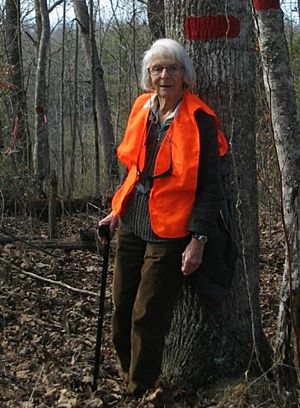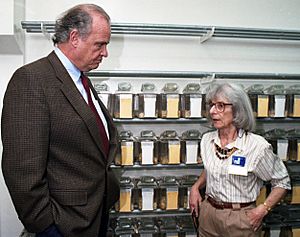Liane Russell facts for kids
Quick facts for kids
Liane Russell
|
|
|---|---|

Lee Russell, hiking in 2011.
|
|
| Born |
Liane Brauch
August 27, 1923 |
| Died | July 20, 2019 (aged 95) Oak Ridge, Tennessee, U.S.
|
| Alma mater | University of Chicago |
| Spouse(s) | William L. Russell |
| Awards | Enrico Fermi Award (1993), Marjory Stoneman Douglas Award (1992) |
| Scientific career | |
| Fields | Genetics, Conservation Movement |
Liane Brauch "Lee" Russell (August 27, 1923 – July 20, 2019) was an amazing scientist and a champion for nature. Born in Austria, she became an American geneticist and conservationist.
Her groundbreaking studies helped us understand how mammals get their sex (male or female) from their chromosomes. She also studied how things like radiation, fuels, and waste can affect the genes of mammals.
Dr. Russell's work taught us a lot about how genes work and how they can be changed or damaged. She found that unborn babies are most at risk from radiation during the first seven weeks of pregnancy. Because of her research, doctors now suggest that non-urgent X-rays for women be done in the 14 days after their period starts. This helps protect any very early pregnancies. She was also the first to discover that the Y chromosome is what makes a mammal male.
Besides her science, she worked hard to protect wild and beautiful places, especially in East Tennessee where she lived.
Contents
Early Life and Family
Liane Brauch was born in 1923 in Vienna, Austria. Her family was Jewish, and she was the oldest of three children. Her father was a chemist, and her mother was a singing teacher.
Her family enjoyed music, skiing, and trips to the Alps. One of her childhood friends was her cousin, Robert Starer, who became a famous composer. Her family had to leave Vienna in 1938 because of the difficult situation for Jewish people during World War II. They secretly escaped to London. Liane moved to the United States in 1941 and became an American citizen in 1946.
She met another zoologist, William L. Russell, during a summer college program. They got married and worked together as geneticists. They had two children, a son named David (born in 1950) and a daughter named Evelyn (born in 1952).
Education and Learning
Liane finished her high school studies in England. After her family moved to the United States, she went to Hunter College in New York City, where she earned her first degree in 1945.
She then went on to get her Ph.D. in Zoology from the University of Chicago in 1949.
A Career in Science
Dr. Russell started her science career at Jackson Memorial Laboratory in 1943. In 1947, she moved to Oak Ridge National Laboratory (ORNL), where she became a top scientist.
She focused her research on how radiation can cause changes in genes. She and her husband created a "mouse house" at ORNL. This was a special colony of over 200,000 mice that they used to study the effects of radiation. This large group of mice helped scientists learn a lot about mammal genetics for many years.
In 1955, she was a scientific advisor for the U.S. team at the first Atoms for Peace Conference in Geneva. In 1973, she was the first woman to receive the Roentgen Medal, an international award.
From 1975 to 1995, Dr. Russell led the Mammalian Genetics & Development Section at ORNL. Under her leadership, the team also studied how chemicals from medicines, fuels, and waste affected mice. Her work helped science move from studying basic genetics to looking at genes at a tiny, molecular level.
In 1986, she was chosen to be part of the National Academy of Sciences. In 1993, she received the Enrico Fermi Award, which is the highest research honor from the U.S. Department of Energy. She earned this award for her amazing work in genetics and radiation biology. This included her discovery of how chromosomes decide sex in mammals and her studies on how radiation affects developing embryos.
Dr. Russell published more than 150 scientific papers. In 2001, ORNL opened the William L. and Liane B. Russell Laboratory to honor her and her husband's work. She retired in 2002. In 2013, ORNL created the Liane B. Russell Distinguished Early Career Fellowship to help young scientists.
Protecting Nature

Dr. Russell was also a dedicated conservationist. She worked to protect wild lands and rivers. In 1966, she helped start the Tennessee Citizens for Wilderness Planning (TCWP).
In 1976, TCWP helped protect the 125,000-acre Big South Fork National River and Recreation Area. They also helped get the Obed River named a National Wild and Scenic River. In 1992, she received the Marjory Stoneman Douglas award from the National Parks Conservation Association.
Awards and Honors
- Roentgen Medal, 1973
- Hunter College Hall of Fame, 1979
- Marjory Stoneman Douglas Award, 1992
- Environmental Mutagen Society Award, 1993
- Enrico Fermi award in 1993
- Elected to the National Academy of Sciences, 1986
See also
 In Spanish: Liane Russell para niños
In Spanish: Liane Russell para niños

